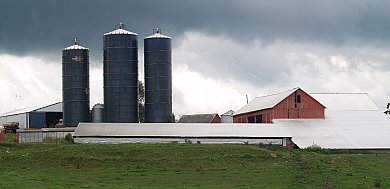MOULTRIE, Ohio — Nestled in the rolling hills of Columbiana County is a farm that can trace its roots back 200 years.
Think about this: The Hahn family owned the property before the Civil War even began.
It was founded before James Madison became president and when Abraham Lincoln was a baby.
History revisited
According to an original will for John Hahn recorded in 1826, the Hahn farm was bought through a grant from President Thomas Jefferson.
Generations later after the original John Hahn, another John Hahn owns and operates the farm. And yet today, it remains the main source of income for the Hahn family.
Hahn said he was going through the attic of what is believed to be the original house and found a will from the original John Hahn. Today it is considered a treasured part of his family’s history.
Court records
Although the will was recorded after the death of John Hahn that year, it clearly states the original Hahn farm was purchased in 1809, according to the old court documents.
The documents are typed and include not only the title and abstract of the land, but it also includes a detailed surveyor’s description of the property in West Township and the will itself. The pages have turned yellow with age and some of the English used is not how we talk today, but it is readable.
The original will distributes the 701 acres to six of his seven children. Even Hahn’s daughters and their husbands were given a piece of land, but it was deeded over to their children, as land at that time was not directly given to the women in a family.
Times have changed. Hahn not only left behind seven children but his wife, Elisabeth as well. The will gave the most land to a son, Peter, and, in exchange, he provided a room for his mother to occupy in the original homestead. She also received some cattle and was to be allowed to use enough ground for a garden.
In addition, she was given 15 bushels of wheat, flax, 5 pounds of wool a year, 50 pounds of pork, 50 pounds of beef, 12 bushels of potatoes and a sufficient supply of firewood every year.
Hahn Farm
Today, John and his wife, Faith, raise corn, soybeans, hay and dairy cattle on the 550-acre farm, which includes the original Hahn property. Their three children — Jonathan, Chris and Larissa — add another generation to the farm.
Jonathan hopes to one day take over the business with his wife, Charlie.
The farm is located on what is now Bayard Road, but was known as Hahn Road for many years until it was changed by the U.S. Postal Service in the 1980s.
Perseverance
Just like generations before, the Hahn family is facing tough financial times due to the current economy, specifically low milk prices, and Hahn said the biggest issue he has had to deal with is the stress from farming.
“We’ve got more going out than coming in,” Hahn said. “I always thought farming was the best way of life– today I’m not so sure.”
But just like those other generations, the Hahn family is dedicated to surviving the turbulent economy.
Dedication
Looking back at photographs found in the attic, Hahn can trace the family’s roots back at least six generations on the farm through pictures. He said the past generations persevered, and he is confident his family will as well.
“They believed in hard work and had trust in the Lord,” Hahn said, the same beliefs held today in his family.
Farm survival
Hahn said there is one thing that he thinks helped farmers survive past economic hard times and he thinks it should be revisited.
He said farmers used to share equipment. Instead of each farm having high equipment expenses, he would like to see everyone working together.
Hahn pointed out the cost of some pieces of equipment is over $200,000 and sometimes each farm may have two or three implements that cost that much. In the past, farmers used each other’s equipment and believed in helping each other to get the work done — and he believes more of that needs to be done today.
“They wouldn’t have survived without good neighbors and a good community. And I believe those same values are needed if we are going to make it in farming,” Hahn said.
On the fireplace mantle sits pictures of the Hahn family. Six generations of men are grouped in three pictures, all of whom farmed the same land over the past 200 years. Now, John sits and ponders how many or if any more generations will be able to craft a life of farming.










